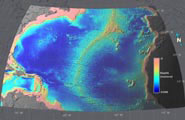Global
Global Mapping-What is the Shape of the Ocean Basins and Continents?
 |
With 70% of the Earth’s surface covered by the ocean, mapping the seafloor represents not only a large endeavor, but also a very large part of understanding the shape of our planet. The bathymetry of the ocean basins has a direct impact on physical, chemical, and biological oceanography. It is also critical to have an accurate map for conducting research in marine geology and plate tectonics. Instruments on ships provide very accurate maps of the seafloor, but are not practical for mapping 70% of the Earth. It would take over 125 years to map the seafloor using a ship at a 100 m horizontal resolution! Instead, scientists use remote sensing to work with such large scales. Remote sensing employs both satellites and aircraft to provide a global map of the seafloor.
A sensor called a radar altimeter sensor is mounted on a satellite to detect the height of the sea surface. In oceanography, the height of the sea surface is directly related to the underlying seafloor topography. The radar altimeter accurately measures altitude by sending microwave energy towards the surface of the Earth. The travel time of this energy down to the Earth and back to the sensor is recorded, and converted to the height of the sensor above the surface. The height of the sea surface is compared to a reference point. These data are then converted to seafloor topography using a complex mathematical model. The final dataset is used to create a bathymetric map of the seafloor. The accuracy of these maps is 5-10 km for location and 100-250 m in depth. For specific areas of interest (such as Lost City), ground-truthing is required to verify bathymetric features of interest. This is typically done using sonar instruments on a ship. that create detailed, high resolution maps on a local scale.
|